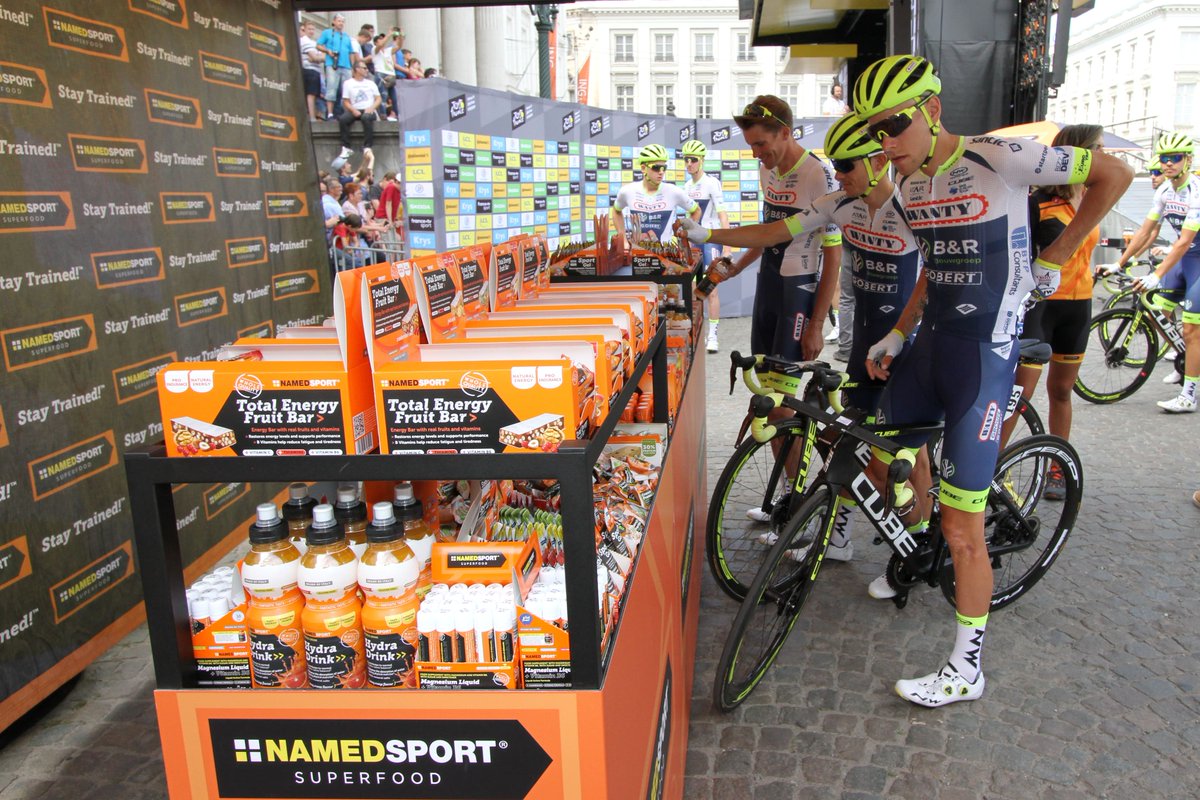C. PRUDHOMME'S COMMENT
After a rest day, the peloton will set off towards the Pyrenees starting by a visit of the Tarn department. The team mates of the sprinters should be put to contribution on this course that they can consider as a fine opportunity or potentially a trap! They’ll need to be extremely focused and powerful to organise a bunched sprint just by the “Capitole” building.
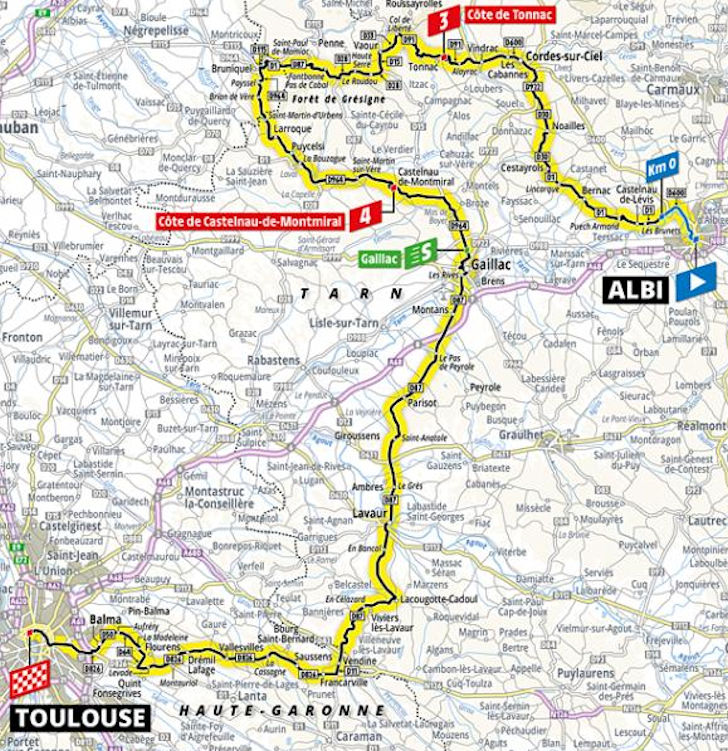
In 2013, while Albi had just been elected by L’Équipe "Most Sporting City of France" of the year 2012, it was Peter Sagan who had prevailed in the prefecture of Tarn at the end of a long stage from Montpellier. It was Slovakia's fourth stage victory and allowed him to widen the gap in his race to win the green jersey.
Albi is the hometown of Lilian Calmejane, solo winner of Les Rousses in the Tour 2017 and one of the most admirable attackers of the current peloton.
Some of the biggest names in cycling have won in Albi, starting with the biggest of all, Eddy Merckx, who took a time trial in 1971. In 2007, Cadel Evans also triumphed in a lonely effort. Another winner of the Tour, Roger Pingeon took a step from Font-Romeu in 1968.
The Tour never goes far from Toulouse but it has not actually finished in the city since 2008. It still landed twice in Blagnac, site of the city airport, in 2012 and in 2017. Or in Cugnaux in 2011 and in Muret in 2015, two cities located in the urban area of the “pink city”. 2008 was the year of the revelation of Mark Cavendish, who won i the second of his thirty victories on the Tour. The Mannish rider had opened his meter three days earlier in Chateauroux. The terrain is indeed favourable for sprinters, and it is not surprising to find the names of Rik Van Steenbergen, Andre Darrigade or Jacques Esclassan among the stage winners near Place du Capitole. But it was also in a bunch sprint that the most prestigious stage winner in Toulouse, Gino Bartali, won in 1948. On the map of the inaugural Tour of 1903, the city had from 1909 been snubbed by the race for thirty years. Henri Desgrange was bored to death during the stage won in 1909 by Jean Alavoine and decided to ignore Toulouse and head for the Pyrenees to make the race more exciting! The idea paid off.
There are countless riders born in Toulouse, but the best known are probably Jean-Christophe Péraud, second in the 2014 Tour or Frederic Moncassin, winner of two stages in 1996. Sylvain Marcailllou, 5th of the 1937 Tour, as well as Christian Chaubet or Robert Forest in the 80s, also represented Toulouse on the roads of the Tour. In the current peloton, Toulouse's Anthony Perez made his debut in 2018.
Km 112.5
Lavaur
Capital of the country of Cocagne, a high place of the crusade against the Albigensians (siege of Lavaur in 1211), Lavaur is famous for its St. Alain cathedral and its round tower, from where the Cathars fought the Catholic soldiers of Simon de Montfort, its big Saturday market and its paper mills. In 2011, Lavaur hosted a Tour de France stage won by Mark Cavendish in a bunch sprint. That day, the Briton seized the green jersey he kept all the way to Paris. Ten years earlier, Rick Verbbrughe had won solo in Lavaur.
Km 2
Castelnau-de-Lévis
Château de Castelnau-de-Lévis
From its promontory, its impressive 40-metres-high tower overlooks the Albi region and yet its history is little known. The castle was built in the 13th century by Sicard Alaman, a close friend of Count of Toulouse Raymond VII, whose goods were confiscated after the Albigensian Crusade and who asked his aide to build a fortress while he was forbidden to do so. The construction took place between 1235 and 1256. The place changed hands until the French Revolution when it was demolished, sold and turned into a quarry. Lots of the village houses were made from its stones. Listed as a historical monument in 1909, it was finally bought by the commune in 1991. Since then volunteers have been working hard to restore its vestiges under the guidance of a French national heritage architect.
Km 23
Cordes-sur-Ciel
Cordes-sur-Ciel is the first and the most visited of all the bastides (fortified towns) of the Tarn. It was founded by Count of Toulouse Raymond VII in 1222 during the Albigensian Crusade. Its creation allowed Cathars in the neighbourhood to find a safe haven. For strategic reasons, the village was built on top of the Puech de Mordagne hill. In the late 13th century, Cordes became extremely wealthy as 6,000 inhabitants – as much as in Albi – manufactured leather, linen and rope. It is the period when the town built the elegant Gothic mansions that still attract tourists to this day.
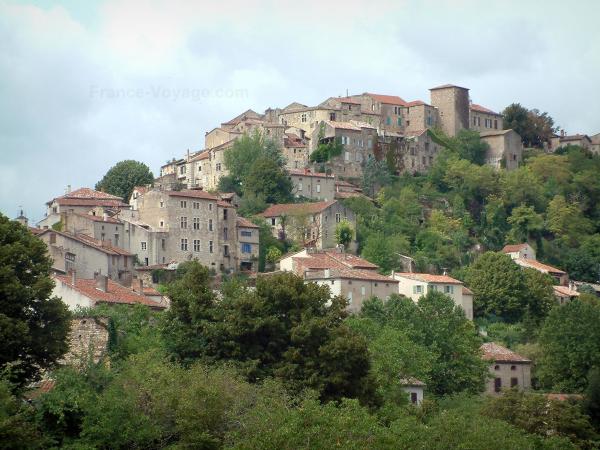
Km 40
Vaour
Dolmen of Vaour
At the crossing of the D91 and D15 roads, the dolmen is the most famous megalith in the department. Listed as a historical monument, it was searched in 1940 and consolidated in 1984.
Templar House
The house was neglected and collapsed in the early 20th century. It was built by the Templars and then went to the Knights Hopsitaller and the Order of Malta. But the vaulted stables are well preserved. Close to the house is a spring which was worshipped by the Gauls.
Km 48
Penne
The medieval village of Penne was once home to an extraordinary character known as “Le Terrible de Penne”. Born in1835 and deceased in 1911, the former surveyor stopped and shaving and cutting his hair and started wandering around the country holding a lamp to symbolise justice. A defender of the poor, at odds with the administration, he stood for several elections, sometimes against Jean Jaures, and was always beaten. He moved to Paris, was taken to a mental institution and sent back to Penne, where he died.
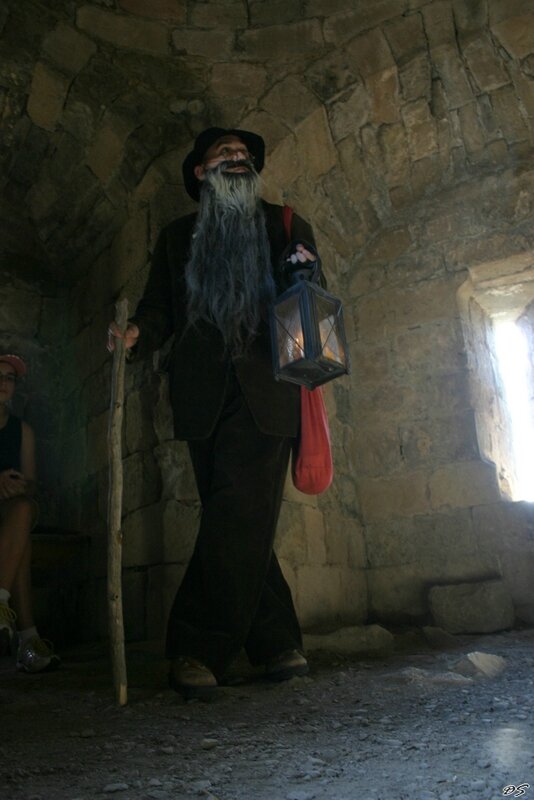
Château de Penne d’Albigeois
The castle was mentioned as early as the 11th century. In 1096, Geoffrey of Penne went on a crusade with Count of Toulouse Raymond V. Adelais of Penne was also sung by troubadours and by Jordan, viscount of St. Antonin. From the impressive fortress which resisted the assaults and sieges of Simon de Monfort, only remains a Romantic figure standing on a rock overlooking the Aveyron. For three centuries, its ruins were used as a quarry for villages to build their houses. The castle was closed to the public for more than 450 years but reopened thanks to its new landlord, Axel Letellier, who has organised visits since 2010.
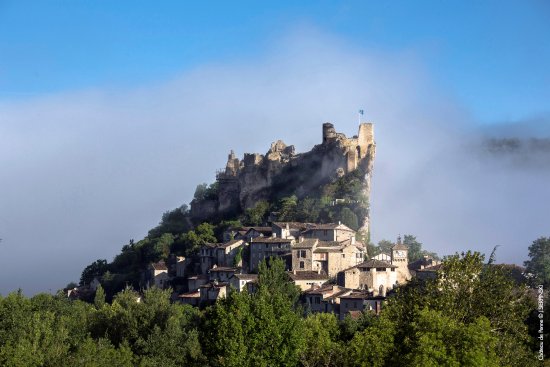
Km 55.5
Bruniquel
Taking advantage of its geographical situation, the city experienced in the Middle Ages a remarkable growth. It was a place of passage for merchants and a stop for pilgrims on their way to Santiago de Compostela, who stayed in the St. Catherine Hospital, opened in 1303. Streets retained evocative names: rue Bombecul (bouncing arse), rue Trotte Garces (trotting whores), Place des marmites. The legend attributes the foundation of the Bruniquel Castle to Merovingian Queen Brunhilda. A property of the counts of Toulouse in the 12th century, the castle was shared two centuries later between two branches of the House of Comminges, which explains the division into "old castle" and "young castle". They were used as a setting for Robert Enrico's film Le Vieux Fusil (The Old Gun), starring Romy Schneider and Philippe Noiret.
Km 65
Puycelsi
Even if Puycelsi is not a “bastide”, the village belongs to the history of the Bastides by its fortified aspect. Built in the Middle Ages, the ramparts were equipped with seven defence towers and pierced with two gates: the Irissou Gate (the portcullis) and the Navistour Gate. The creation of the village took place around an old Benedictine monastery of which only remains today the imposing church dedicated to St. Corneille. Puycelsi (the mount of heaven), preserved remains of its religious past like the St. Roch chapel, built in 1703 to protect the population against the plague, the St. Jacme chapel, which belonged to the Templars of Vaour, as well as the monogram of Christ IHS to be found on several town-houses, indicating that a small religious congregation lived there.
Km 87
Gaillac
Built around the St. Michel Abbey in 972, the town of Gaillac (Latin Gallus: rooster), has since been renowned for its wine. It retained from its past a superb abbey and a magnificent abbatial church both built above the banks of the Tarn, a river that the monks used to transport their wines to Bordeaux and beyond. The districts of Portanelle and Petit Train or the beautiful Place du Griffoul with its arcades evoke the medieval or Renaissance periods of the city.
A rugby stronghold, the city has seen internationals like Eric Blanc, Bernard Laporte or Vincent Moscato play for its local team.
St. Michel Abbey
The St. Michel Abbey spurred the agricultural and economic growth of Gaillac by the exploitation of the vineyard sand the commercial traffic of the wine on the river Tarn. The abbey was partly rebuilt in 1271. In 1524, it was secularised, a chapter of canons replacing the community of monks, but the abbey title was preserved. Twice devastated by the Protestants, the building was rebuilt and redecorated from 1570 to 1620. In 1849 the north entrance was closed, another was opened on the west facade, where a neo-Romanesque portal was built (work of Alexandre du Mège). Major restoration work since the end of the 19th century was undertaken until the complete renovation of the abbey buildings in the 1990s.
Km 112.5
Lavaur
St. Alain Cathedral
The beautiful brick building, of southern Gothic style, was built in 1255. The structure overlooking the Agout is characterised by a single nave lined with chapels (14th and 15th centuries), and to the west by a powerful bell tower with a monumental portal (late 15th and early 16th). Its polychrome carved wooden organ case (1523) is a masterpiece of Renaissance art in the South of France. The Cavaillé-Coll organ was installed in 1876. The restoration of the painted decor was completed in 2016. The city of Lavaur is the only one in the South-West of France to have a “Jacquemart” or bell-striker, a 17th century wooden automaton ringing the hours at the top of the cathedral tower



